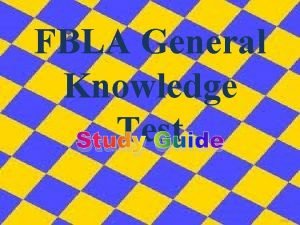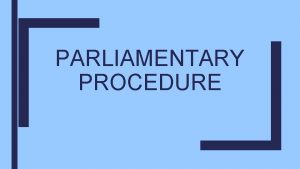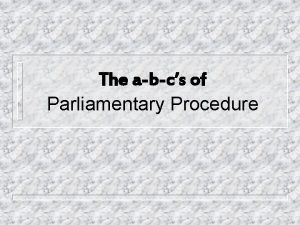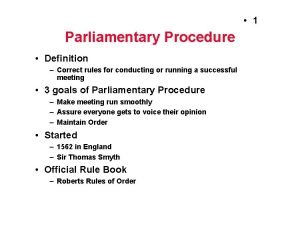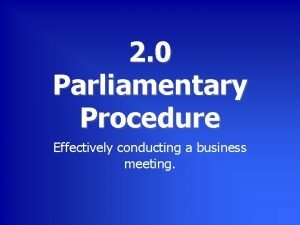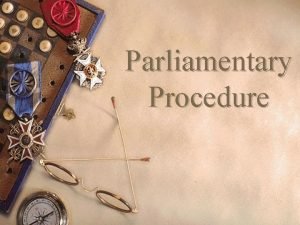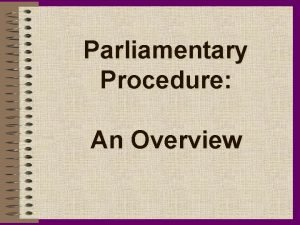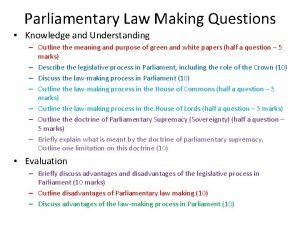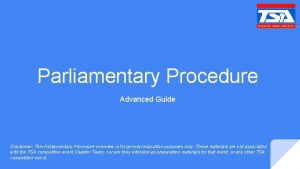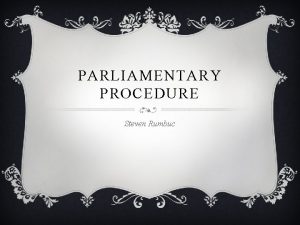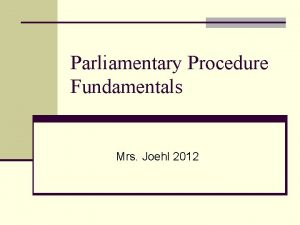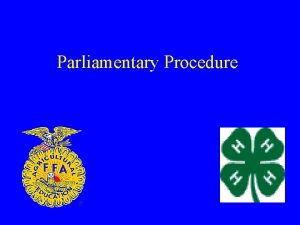Parliamentary Procedure Advanced Guide Disclaimer This Parliamentary Procedure











- Slides: 11

Parliamentary Procedure Advanced Guide Disclaimer: This Parliamentary Procedure overview is for general education purposes only. These materials are not associated with the TSA competitive event Chapter Team, nor are they intended as preparation materials for that event, or any other TSA competitive event.

Table of Contents Committees Motions Subsidiary Motions Privileged Motions Incidental Motions Restorative Motions Voting

Committees A committee is a group created by an assembly to be accountable for some specific function, and which is usually much smaller than the assembly. There are two types of ordinary committees that are used most of the time. They are: ● Standing Committees: Standing committees are typically established in an organization’s bylaws and serve a permanent and continuing function for the organization. In the national TSA bylaws, it states that the National TSA Executive Committee (comprised of the six national officers and the national TSA advisor) has the power to appoint standing committees as necessary. ● Special Committees: Special committees, also known as an ad hoc committees, are created by a motion to form a committee to carry out a clearly defined, temporary function. These committees exist until they complete their work and report to the assembly. In the national TSA bylaws, it states that the National TSA Executive Committee has the power to appoint special committees as necessary.

Motions A motion is a formal proposal by a member of an assembly that some action be taken. Usually, in order for a motion to be considered, a member other than the motion’s sponsor must second the motion, which is a verbal expression of agreement that the motion should be considered. Once a motion has been made and seconded, the assembly’s chair puts it before the assembly for consideration. At that time some motions are debatable, and others are not. At the end of debate, the assembly votes, and the chair announces the result. There are five types of motions: ● Main Motions: Introduce a unique, substantive proposal. For example, a motion that the assembly purchase a new property is a main motion. Sometimes, a motion elsewhere defined in Robert’s Rules can be made as a stand-alone motion, such as a motion to limit debate, while no other motion is being considered. In such cases, that is called an Incidental Main Motion. A main motion which is not described in Robert’s Rules is called an Original Main Motion. ● Subsidiary Motions: Assist the assembly in handling some other motion. For example, a motion to amend the current motion is a subsidiary motion. ● Privileged Motions: Deal with immediately pressing questions that are not directly relevant to the motion being considered. For example, the motion to take a recess is a privileged motion. ● Incidental Motions: Affect how the assembly considers the current motion, usually by enforcing or changing the rules of order. For example, the motion to suspend a rule is an incidental motion. ● Restorative Motions: Allow the assembly to reverse or reconsider the decision previously made on some other motion. For example, the motion to reconsider a main motion is a restorative motion.

Subsidiary Motions Subsidiary motions are secondary motions that help dispose of other motions during a meeting. There are seven subsidiary motions: ● Postpone Indefinitely: This motion avoids uncomfortable decisions. Adopting this motion means that your assembly has agreed to not cast a vote on the motion this is applied to. Requires a majority. ● Amend: Amend is the most commonly used subsidiary motion. The motion to amend is used to offer a substantive change to the motion that is being considered. Requires a majority. ● Commit or Refer: This motion sends a motion to a committee, special or standing. That way, the committee can research or take some action, and report back at a later meeting. Requires a majority. ● Previous Question: The previous question is used to immediately end debate and vote on one or more of the motions being considered. Requires a two-thirds vote, since it affects the rights of members. ● Postpone Definitely: This motion reschedules the consideration of the pending motion to another time during the present session or the next regular session. Requires a majority. ● Limit or Extend Limits of Debate: This motion is used to change the amount of time members have to speak, the number of times they may speak, or to set a time to end debate. Requires a two-thirds vote. ● Lay On the Table: This motion temporarily sets aside the pending motion in order to handle pressing business. If it is not taken from the table by the end of the next session, it dies. Requires a majority.

Privileged Motions Privileged motions are secondary motions that are used to address issues not directly related to the business or how it is conducted. There are five privileged motions: ● Call for Orders of the Day: This motion is used to keep the meeting on schedule with the meeting’s agenda. This is required on demand of a single member. A two-thirds vote is required to reject this call. ● Raise a Question of Privilege: This motion is used when a member asks for consideration of a request or a motion relating to the rights of the assembly or some members. The chair rules whether it is a valid question of priviledge, and if it is, either rules on the request or puts the motion before the assembly. ● Recess: The motion to recess provides a short break in the proceedings. This allows the members to have some time to take care of personal business without disrupting the meeting. Requires a majority. ● Adjourn: The motion to adjourn is a proposal to end the meeting. Requires a majority. ● Fix the Time to Which to Adjourn: This motion sets the time for an adjourned meeting. This is used to schedule another meeting that is a continuation of the current one. Requires a majority.

Incidental Motions Incidental motions are motions that rise out of a current question at hand must be taken care of before business can proceed. There are 15 incidental motions: ● Point of Order: A point of order is called when there is a breach of the rules and requires the issue be immediately considered. No vote is taken on this motion, the chair simply states the ruling of the point. ● Appeal: An appeal is a way to express dissatisfaction with the chair’s ruling. It brings the chair’s ruling into consideration by the assembly. Majority required to overturn the chair’s ruling. ● Suspend the Rules: This motion is used to temporarily set aside rules governing the body. Requires a two-thirds vote if it is a rule of order, or a majority if it a standing rule of the assembly. This motion cannot be used to suspend any rules contained in the bylaws or constitution. ● Objection to the Consideration of a Question: Objecting to the consideration of the question is used to prevent an original main motion from being considered and discussed. Requires a two-thirds vote. ● Division of a Question: This motion is used to separate one motion into two or more motions to be considered separately. It can only be applied to main motions or amendments. Requires a majority. ● Consider By Paragraph (Seriatim): This motion is used to separate a lengthy motion into parts for debate and vote on each piece separately before a vote on the whole. Requires a majority. ● Division of the Assembly: This motion is used to question the result of a voice vote or raise of hands vote by calling for a standing vote. This motion cannot demand any type of vote beyond a standing vote. This is required on demand of a single member.

Incidental Motions Continued ● Motions Related to Method of Voting and the Polls: These motions are used to propose a vote be taken by ballot, roll call, or counted standing vote. It also includes motions to open or close ballot polls. These typically require majority votes, but there a few special cases that require two-thirds votes. ● Motions Related to Nominations: These motions designate a method for taking nominations or open or close nominations. These typically require majority votes, but there a few special cases that require two-thirds votes. ● Request to Be Excused from a Duty: A member may make this motion to shed oneself, or another member, of a compulsory obligation of membership or office. Requires a majority. ● Parliamentary Inquiry: This motion is used to pose a question about parliamentary rules. There is no vote nor a binding ruling, the chair answers the question or refers it to another member. ● Point of Information/Request for Information: This is used by a member wanting information about the pending motion. There is no vote, the chair answers the question or refers it to another member. ● Request for Permission to Withdraw or Modify a Motion: This is used, by the maker of a motion, to withdraw or change a motion. If it has already been stated by the chair, a majority is required. If it has not yet been stated, the maker can withdraw or change their motion without permission. ● Request to Read Papers: This motion is a request to read something to the assembly. Requires a majority. ● Request for Other Privilege: This motion is used to make any request not defined by another incidental motion, such as a member requesting to speak or make remarks when no business is pending. Requires a majority.

Restorative Motions Restorative motions are motions made to bring a motion back into consideration or change the decision, usually as a result of the assembly changing its mind on the matter or new information being available. There are five restorative motions: ● Rescind: Also known as repeal, this motion is used to nullify an adopted resolution, motion, bylaw, section, or paragraph. Requires a majority with previous notice, or a two-thirds vote. ● Amend Something Previously Adopted: This motion is similar to rescind, except it amends the adopted motion rather than nullifying it. Requires a majority with previous notice, or a two-thirds vote. ● Reconsider: This motion allows the assembly to bring back into consideration a motion previously voted on, during the same session. This can only be made by someone who voted on the winning side of the original motion. Requires a majority. ● Take from the Table: This motion is used to bring a motion previously laid on the table back into consideration. Requires a majority. ● Discharge a Committee: This motion proposes to take a matter out of a committee’s hands and allows the assembly to deal with the motion. Requires a majority with previous notice, or a two-thirds vote.

Voting Terms: ● Quorum: The minimum number of members that must be present to consider business at a meeting. Unless bylaws prescribe otherwise, a quorum is the majority of membership. ● Majority: Passes only if more than half of the votes cast are in the affirmative. ● Two-thirds: Passes only if at least two-thirds of the votes cast are in the affirmative. A standing vote, roll call vote, or ballot vote must be taken for motions requiring two-thirds. ● Previous Notice: Notification of members about intent to consider a motion some amount of time before the session, usually at the prior meeting or in the announcement of the meeting. ● Abstention: A member’s choice to cast neither an affirmative nor negative vote. For calculating majority or two thirds, an abstention is treated as if no vote were cast. Voting methods: ● Voice: Members indicate their votes by saying “aye” or “nay” when prompted. ● Show of Hands: Members indicate their votes by raising their hands when prompted. ● Standing: Members indicate their votes by standing when prompted. May be counted in small assemblies. ● Roll Call: Roll is called, with members indicating their votes by responding with “aye” or “nay. ” ● Ballot: Members indicate their votes by submitting ballots. ● Unanimous Consent: Passage of a motion that is obviously uncontroversial is sometimes attained by asking for objections. If none are offered, the motion passes.

Citations Robert, H. M. , Robert, S. C. , Evans, W. J. , Honemann, D. H. , Balch, T. J. Robert's Rules of Order, Newly Revised. 11 th ed. Philadelphia, PA: Da Capo, 2011. Print. Jennings, C. Alan. Robert's Rules for Dummies. 2 nd ed. Hoboken, NJ: John Wiley & Sons, 2012. Print.
 Where was the first fbla chapter located
Where was the first fbla chapter located Division of the house parliamentary procedure
Division of the house parliamentary procedure Parliamentary procedure hosa
Parliamentary procedure hosa Parliamentary procedure model un
Parliamentary procedure model un Abc's of parliamentry procedure
Abc's of parliamentry procedure Parliamentary procedure definition
Parliamentary procedure definition Parliamentary procedure at a glance
Parliamentary procedure at a glance Hosa parliamentary procedure
Hosa parliamentary procedure Parliamentary procedure vocabulary
Parliamentary procedure vocabulary Question of privilege
Question of privilege History of parliamentary procedure
History of parliamentary procedure Parliamentary procedure outline
Parliamentary procedure outline
